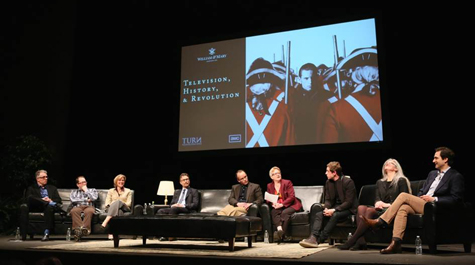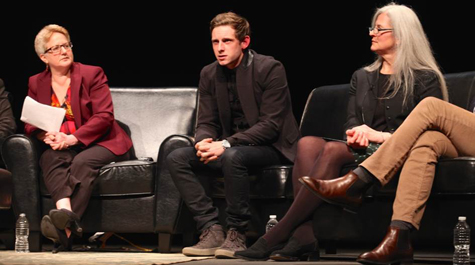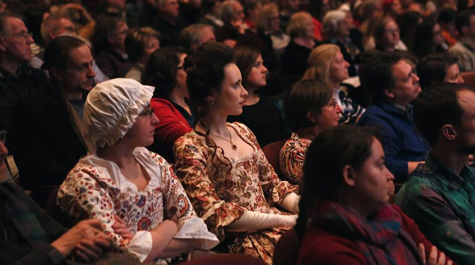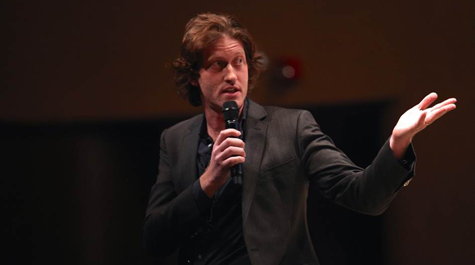TURN event centers on how to tell history's stories
More than 500 people got a sneak peek Tuesday night of the Wren Building’s Great Hall transformed into King George III’s throne room in AMC’s TURN: Washington’s Spies.
They also got a chance to see the show’s stars and producers interact with William & Mary professors in a wide-ranging discussion, “Television, History and Revolution,” that cut to the heart of differences between academic history, popular history and historical drama.
Fans of the Revolutionary War drama that recounts the true story of the Culper Ring were surprised to find that not only did leading actor Jamie Bell (Abraham Woodhull) appear as announced, but he was also joined by Heather Lind (Anna Strong), Samuel Roukin (John Graves Simcoe) and Aldis Hodge (Jordan). Also representing TURN were executive producers Craig Silverstein and Barry Josephson, plus Alexander Rose, author of the popular history book Washington’s Spies: The Story of America’s First Spy Ring, which inspired the series. Rose served as a consultant last season and joined the writing staff for season two.
The W&M side of the panel featured Arthur Knight, associate professor of American studies, English and film and media studies; Joshua Piker, history professor and editor of the William & Mary Quarterly; Susan Kern, history professor and executive director of the Historic Campus; and Karin Wulf, director of the Omohundro Institute for Early American History. History Professor and Department Chair Cindy Hahamovitch moderated the event.
{{youtube:medium:left|0HuCjYjT5KM}}
In a sense, the use of the Wren itself is a metaphor for the difference in historical perspectives. As the oldest college building standing in the United States, it represents one thing to W&M historians. But to the show’s producers, it proved the “perfect” backdrop as the king’s throne room when they filmed on campus last fall, and yet still required computer generated changes to transform it for the opening scene of TURN’s upcoming second season.
“When we saw the Wren Building, of course we thought, ‘We have to use this building,’” Josephson said. “It’s so magnificent … That said, it needed to have a few other qualities given to it. Through the miracle of CG graphics, we were able to do that. So we replaced the ceiling and hung tapestries and so on.”
Changes to the Wren are just one example of the historical details rearranged in the show. Others have noted that the show opens in 1776, though in reality the Culper Ring didn’t become active until 1778. Neither did the British Army actually occupy Setuaket in New York’s Long Island. But the show’s producers explained that each deviation from historical accuracy is debated and weighed against the viewers’ needs.
“To bring people into a world that they don’t know, you’ve got to give them some touchstones of the world that they are familiar with,” Silverstein said. So Redcoats are stationed in Setauket in the show because they are instantly recognizable, more so than the historically accurate loyalist regiment.
Complete accuracy is “just kind of tedious to tell you the truth,” Rose said. “Also, you need colossal budgets. And it appeals to point-zero-one percent of the audience –”
“— Except in Williamsburg,” Hahamovitch deadpanned.
{{youtube:medium:left|nXDThK3NFqk}}
Hahamovitch said one of the show’s strengths is its emphasis on the plights of everyday people over famous figures. It’s not until the fifth episode, for example, that George Washington is shown.
“You really tell the story from what historians call the bottom up,” she said. “It’s a social history perspective with very ordinary people for quite a long time before any of those famous people appear.”
Wulf agreed that the usual narrative of the Revolutionary War is “very Boston-centric,” where staunch patriots emerged before the war and remained so throughout. “But in New York, especially on Long Island, you get a more complex picture … All over the colonies, people’s loyalties are shifting and not necessarily because they are in opposition to the occupiers, but because they have a political allegiance to a landowner or somebody they owe money to. For all kinds of reasons people are choosing one side or another that have nothing to do with ideology or any understanding of a political position.”
“It was a way to shake up a very preserved-in-amber tale,” Silverstein explained. “I didn’t learn much about [the Revolutionary War] past middle school … It was almost presented as a rite of citizenship: They came, they were oppressive, we fought back and we won. And it’s so much more complicated than that, and spies were much more complicated people, people in a shadowy world which you don’t think about.”
Knight said the show partially conveys that world through camera work that gives viewers a 360-degree view of the characters and town. “One of the things that’s saying is, ‘Look, they exist in a world. This isn't a set.’ If we move the camera around this way where you expect somebody to be holding a microphone, nobody's there. There's other stuff; there's a material world.”
Kern said that’s another difference from how academic historians tell stories. Recounting a historical scene, an academic historian might only describe the clothing of the major players. “We wouldn’t have to dress everyone else. You had to make a lot more decisions about things in that scene than anyone writing a history book would have to do.”
Also, by setting much of TURN in small-town Setauket, the show’s producers were able to intimately explore manifold aspects of everyday life during the late 1700s, including issues of gender and race.
“Many of the dates are accurate. Many of the people did really exist in that form, but the storytelling is different because we have to entertain on an episode-to-episode basis, to keep people involved, to keep them intrigued,” Josephson said.
“It’s entertainment at the end of the day, but I think we’re trying very much to be true and accurate to the period and to the stories of the people.”
 Skip to main content
Skip to main content




